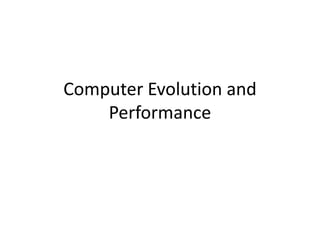ch2 -A Computer Evolution and Performance updated.pdf
- 2. ENIAC - background • Electronic Numerical Integrator And Computer • Eckert and Mauchly • University of Pennsylvania • Trajectory tables for weapons • Started 1943 • Finished 1946 – Too late for war effort • Used until 1955
- 3. ENIAC - details • Decimal (not binary) • 20 accumulators of 10 digits • Programmed manually by switches • 18,000 vacuum tubes • 30 tons • 15,000 square feet • 140 kW power consumption • 5,000 additions per second
- 4. von Neumann/Turing • Stored Program concept • Main memory storing programs and data • ALU operating on binary data • Control unit interpreting instructions from memory and executing • Input and output equipment operated by control unit • Princeton Institute for Advanced Studies – IAS • Completed 1952
- 5. Structure of von Neumann machine
- 6. IAS - details • 1000 x 40 bit words – Binary number – 2 x 20 bit instructions • Set of registers (storage in CPU) – Memory Buffer Register – Memory Address Register – Instruction Register – Instruction Buffer Register – Program Counter – Accumulator – Multiplier Quotient
- 8. Commercial Computers • 1947 - Eckert-Mauchly Computer Corporation • UNIVAC I (Universal Automatic Computer) • US Bureau of Census 1950 calculations • Became part of Sperry-Rand Corporation • Late 1950s - UNIVAC II – Faster – More memory
- 9. IBM • Punched-card processing equipment • 1953 - the 701 – IBM’s first stored program computer – Scientific calculations • 1955 - the 702 – Business applications • Lead to 700/7000 series
- 10. Transistors • Replaced vacuum tubes • Smaller • Cheaper • Less heat dissipation • Solid State device • Made from Silicon (Sand) • Invented 1947 at Bell Labs • William Shockley et al.
- 11. Transistor Based Computers • Second generation machines • NCR & RCA produced small transistor machines • IBM 7000 • DEC - 1957 – Produced PDP-1
- 12. Microelectronics • Literally - “small electronics” • A computer is made up of gates, memory cells and interconnections • These can be manufactured on a semiconductor • e.g. silicon wafer
- 13. Generations of Computer • Vacuum tube - 1946-1957 • Transistor - 1958-1964 • Small scale integration - 1965 on – Up to 100 devices on a chip • Medium scale integration - to 1971 – 100-3,000 devices on a chip • Large scale integration - 1971-1977 – 3,000 - 100,000 devices on a chip • Very large scale integration - 1978 -1991 – 100,000 - 100,000,000 devices on a chip
- 14. Moore’s Law • Increased density of components on chip • Gordon Moore – co-founder of Intel • Number of transistors on a chip will double every year • Since 1970’s development has slowed a little – Number of transistors doubles every 18 months • Cost of a chip has remained almost unchanged • Higher packing density means shorter electrical paths, giving higher performance • Smaller size gives increased flexibility • Reduced power and cooling requirements • Fewer interconnections increases reliability
- 15. x86 Evolution (1) • 8080 – first general purpose microprocessor – 8 bit data path – Used in first personal computer – Altair • 8086 – 5MHz – 29,000 transistors – much more powerful – 16 bit – instruction cache, prefetch few instructions – 8088 (8 bit external bus) used in first IBM PC • 80286 – 16 Mbyte memory addressable – up from 1Mb • 80386 – 32 bit – Support for multitasking • 80486 – sophisticated powerful cache and instruction pipelining – built in maths co-processor
- 16. x86 Evolution (2) • Pentium – Superscalar – Multiple instructions executed in parallel • Pentium Pro – Increased superscalar organization – Aggressive register renaming – branch prediction – data flow analysis – speculative execution • Pentium II – MMX technology – graphics, video & audio processing • Pentium III – Additional floating point instructions for 3D graphics
- 17. x86 Evolution (3) • Pentium 4 – Note Arabic rather than Roman numerals – Further floating point and multimedia enhancements • Core – First x86 with dual core • Core 2 – 64 bit architecture • Core 2 Quad – 3GHz – 820 million transistors – Four processors on chip • x86 architecture dominant outside embedded systems • Organization and technology changed dramatically • Instruction set architecture evolved with backwards compatibility • ~1 instruction per month added • 500 instructions available • See Intel web pages for detailed information on processors
- 28. Embedded Systems ARM • ARM evolved from RISC design • Used mainly in embedded systems – Used within product – Not general purpose computer – Dedicated function – E.g. Anti-lock brakes in car
- 29. Embedded Systems Requirements • Different sizes – Different constraints, optimization, reuse • Different requirements – Safety, reliability, real-time, flexibility, legislation – Lifespan – Environmental conditions – Static v dynamic loads – Slow to fast speeds – Computation v I/O intensive – Descrete event v continuous dynamics
- 30. Possible Organization of an Embedded System
- 31. ARM Evolution • Designed by ARM Inc., Cambridge, England • Licensed to manufacturers • High speed, small die, low power consumption • PDAs, hand held games, phones – E.g. iPod, iPhone • Acorn produced ARM1 & ARM2 in 1985 and ARM3 in 1989 • Acorn, VLSI and Apple Computer founded ARM Ltd.
- 32. ARM Systems Categories • Embedded real time • Application platform – Linux, Palm OS, Symbian OS, Windows mobile • Secure applications































